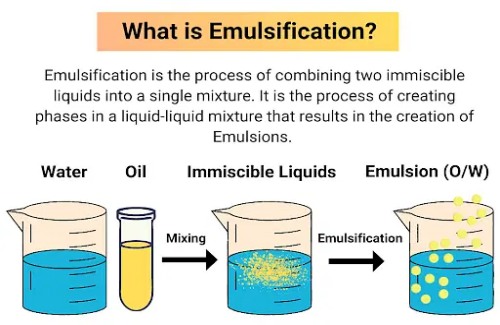Uncover the Benefits of Utilizing an Emulsifier in Food for Improved Culinary Experiences
Emulsifiers are typically forgotten yet crucial elements in culinary methods. They help with the blending of diverse components, enhancing both taste and texture. By ensuring security, emulsifiers stop the unattractive splitting up of mixtures. Their convenience spans numerous applications, from sauces to dressings. Understanding their function can bring about significant renovations in food top quality and discussion. What particular advantages do emulsifiers offer that can transform day-to-day recipes right into remarkable culinary experiences?
Understanding Emulsifiers: What They Are and Just how They Work
Emulsifiers play an essential role in the food industry, acting as agents that promote the mixing of water and oil, two compounds that usually do not mix. These compounds have both hydrophilic (water-attracting) and hydrophobic (oil-attracting) residential or commercial properties, enabling them to maintain combinations by lowering the surface area stress in between the two phases. Typical emulsifiers consist of lecithin, mono- and diglycerides, and certain healthy proteins.
When added to food items, emulsifiers produce a steady solution, preventing splitting up and ensuring an uniform texture - Emulsifier In Food. They are vital in several applications, varying from salad dressings and mayonnaise to ice cream and sauces. By keeping the stability of mixtures, emulsifiers not just enhance the visual allure of food yet also boost mouthfeel and uniformity. Their capability to stabilize emulsions makes them important in modern-day food formulation, adding substantially to the high quality and shelf life of numerous products
The Role of Emulsifiers in Taste Improvement
While commonly neglected, emulsifiers considerably contribute to flavor improvement in food items. They play a necessary function in boosting the total preference experience by assuring that flavor substances are equally dispersed throughout a meal. By stabilizing solutions, such as sauces or dressings, emulsifiers avoid the splitting up of oil and water, enabling tastes to fuse together much more efficiently. This consistent distribution not just magnifies the preference but additionally guarantees that each bite is continually delicious.
Emulsifiers can improve the perception of specific flavors, making them more obvious on the taste buds. They might interact with details active ingredients, assisting to release unstable flavor substances that add to a recipe's fragrant account. Subsequently, making use of emulsifiers can greatly raise the culinary experience, changing straightforward recipes into complicated and delightful taste trips. Their refined yet impactful duty in flavor improvement must not be undervalued in the art of food preparation.
Emulsifiers and Texture: Producing Creamy and Velvety Cuisines
The influence of emulsifiers expands past taste improvement to the domain of texture, where they contribute in developing luscious and silky meals. By facilitating the uniform distribution of fats and water, emulsifiers allow the development of steady solutions, leading to an elegant mouthfeel. This is especially evident in items like mayo, sauces, and dressings, where a smooth, velvety uniformity is preferred.
Emulsifiers such as lecithin and mono- and diglycerides function to minimize surface tension in between ingredients, enabling an unified blend that boosts the sensory experience. The velvety structure accomplished through emulsification can raise meals, making them extra attractive and pleasurable. Furthermore, the ability to produce a velvety appearance enables chefs to incorporate numerous active ingredients without compromising uniformity, leading to cutting-edge culinary developments. Basically, emulsifiers play an essential role in transforming normal meals into remarkable cooking experiences with texture improvement.
Stability Issues: How Emulsifiers Prevent Splitting Up
A vital facet of culinary emulsifiers is their capability to stop separation, making certain that products maintain their intended appearance and look over time. Emulsifiers work by stabilizing mixes of oil and water, which naturally often tend to divide because of differences in density and polarity. By minimizing surface area stress at the oil-water user interface, emulsifiers facilitate the development of stable solutions, permitting an uniform distribution click for info of active ingredients.

Usual Emulsifiers in Cooking and Their Applications
Understanding the different emulsifiers frequently used in food preparation discloses their substantial duties in enhancing food structure and security. Lecithin, obtained from egg yolks or soybeans, is widely used in mayo and salad dressings, providing a velvety uniformity. Mustard, additionally an emulsifier, aids in stabilizing vinaigrettes while conveying flavor.


Another preferred emulsifier is xanthan gum tissue, regularly made use of in gluten-free baking and sauces for its thickening residential or commercial properties. Guar gum serves a comparable objective, improving the structure of gelato and dairy products.
Mono- and diglycerides, usually found in refined foods, aid boost life span and maintain appearance. Finally, casein, a milk healthy protein, is used in cheese-making and velvety sauces, contributing to a smooth mouthfeel. Each of these emulsifiers plays an important role in culinary applications, ensuring desirable textures and preventing splitting up in diverse food.
Often Asked Concerns
Are Emulsifiers Safe for Individuals With Food Allergies?
Emulsifiers can be safe for individuals with food allergic reactions, depending on the details emulsifier made use of. It is necessary to identify the source of the emulsifier, as some might set off allergies in delicate individuals.
How Do Emulsifiers Affect the Nutritional Web Content of Food?
Emulsifiers can influence the nutritional web content of food by improving vitamins and mineral absorption and improving structure. Their presence may additionally dilute certain nutrients, depending on the food matrix, potentially modifying general nutritional worth.
Can Emulsifiers Be Made Use Of in Vegan Cooking?
Emulsifiers can be efficiently made use of in vegan cooking, providing structure and security to recipes. Plant-based emulsifiers like lecithin, derived from soy or sunflower, help blend components, improving the total high quality of vegan cooking productions.
What Are the Ecological Impacts of Emulsifier Production?
The environmental effects of emulsifier production commonly include deforestation, water pollution, and high power consumption. In addition, some resources of find more information emulsifiers can add to biodiversity loss, elevating problems regarding sustainability in food production methods.
How Do Emulsifiers Contrast to Natural Thickeners in Cooking?
Emulsifiers use smoother appearances and boosted security compared to natural thickeners, which can pass on unique tastes - Emulsifier In Food. While emulsifiers boost mouthfeel and appearance, all-natural thickeners give even more wellness benefits and can add to the meal's taste profile
When added to food products, emulsifiers develop a secure solution, stopping separation and making certain a consistent structure. While commonly ignored, emulsifiers considerably contribute to taste improvement in food items. Comprehending the various emulsifiers commonly made use of in food preparation exposes their significant duties in improving food texture and stability. Emulsifiers can be safe for people with food allergies, depending on the particular emulsifier used. Emulsifiers can affect the dietary content of food by next boosting vitamins and mineral absorption and enhancing appearance.